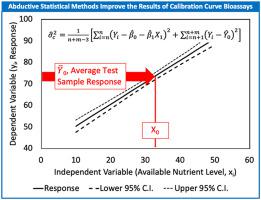Animal Nutrition ( IF 6.1 ) Pub Date : 2022-04-28 , DOI: 10.1016/j.aninu.2022.04.008 Gene M Pesti 1, 2 , Lynne Billard 2 , Shu-Biao Wu 1 , Robert A Swick 1 , Thi Thanh Hoai Nguyen 1 , Natalie Morgan 1

|
In this paper, we discuss the theory behind calibration curve experiments and their application to a zinc (Zn) bioavailability study with broiler chickens. Seven replicates of 16 male commercial broiler chicks were fed starter diets for 14 days. Six diets had different levels of a potential Zn source and one was a positive control with standard industry levels of Zn for comparison. Four commonly used methods of calculating bioavailability means and confidence intervals (CI) from a calibration curve (standard curve) experiment to estimate the bioavailability of a new zinc source in broiler chickens were compared. The methods compared were the following: 1) the Counter-Intuitive Method uses a multiple-range test to compare unknown test and standard samples; 2) the Intuitive Method uses standard linear regression and inverts the equation to predict Zn bioavailability for each replicate of test samples; 3) the Abductive Method uses Graybill's Equation, based on theory and observation, to estimate CI's; and 4) the Sophistic Method uses reverse regression, and calculates Zn bioavailability values directly from the equation. The Counter-Intuitive Method only gives information about which standards the test samples are, or are not, significantly different from respectively (average available Zn not predicted). The Intuitive Method ignores error about the standard curve and theoretically cannot estimate the CI directly ( = 107.5 ± 15.8 mg Zn/kg). The Sophistic Method underestimates and overestimates the test sample mean values above and below the mean of the standards, respectively ( = 96.6 mg Zn/kg). The Abductive Method has an advantage over the other methods: The mean prediction estimation is consistent with theory (107.5 ± 6.1 mg Zn/kg; ). When test or “unknown” samples are near the mean of the standard samples, the CI is smaller than when near the extremes of the calibration curve. When calibration curve error is small (R2 > approximately 0.95), there is little advantage to using the Abductive Method, but when calibration curve error is larger, as in many bioassays with growing animals, the Abductive Method improves the accuracy of the CI calculations. The Abductive Method was used to demonstrate the influence of the number of replicate samples on experimental power and cost.
中文翻译:

溯因统计方法改善校准曲线生物测定的结果:确定肉鸡锌生物利用度的一个例子
在本文中,我们讨论了校准曲线实验背后的理论及其在肉鸡锌 (Zn) 生物利用度研究中的应用。对 16 只雄性商品肉鸡进行 7 次重复饲喂 14 天的起始日粮。六种饮食具有不同水平的潜在锌源,一种是阳性对照,具有标准工业锌水平以进行比较。比较了从校准曲线(标准曲线)实验计算生物利用度平均值和置信区间 (CI) 的四种常用方法,以估计新锌源在肉鸡中的生物利用度。比较的方法如下: 1)反直觉方法使用多范围测试来比较未知测试和标准样品;2) Intuitive Method 使用标准线性回归并反转方程来预测每个重复测试样品的 Zn 生物利用度;3) Abduction Method 使用 Graybill 方程,基于理论和观察,来估计 CI;4) Sophistic Method 使用反向回归,并直接从方程计算 Zn 生物利用度值。反直觉方法仅提供有关测试样品与哪些标准显着不同或没有显着差异的信息(未预测的平均可用 Zn)。Intuitive Method忽略了标准曲线的误差,理论上不能直接估计CI(4) Sophistic Method 使用反向回归,并直接从方程计算 Zn 生物利用度值。反直觉方法仅提供有关测试样品与哪些标准显着不同或没有显着差异的信息(未预测的平均可用 Zn)。Intuitive Method忽略了标准曲线的误差,理论上不能直接估计CI(4) Sophistic Method 使用反向回归,并直接从方程计算 Zn 生物利用度值。反直觉方法仅提供有关测试样品与哪些标准显着不同或没有显着差异的信息(未预测的平均可用 Zn)。Intuitive Method忽略了标准曲线的误差,理论上不能直接估计CI( = 107.5 ± 15.8 毫克锌/千克)。复杂方法分别低估和高估了高于和低于标准平均值的测试样本平均值( = 96.6 毫克锌/千克)。溯因法比其他方法具有优势:平均预测估计与理论一致(107.5 ± 6.1 mg Zn/kg;)。当测试或“未知”样品接近标准样品的平均值时,CI 小于接近校准曲线极值时的 CI。当校准曲线误差较小(R 2 > 约 0.95)时,使用溯因法几乎没有优势,但当校准曲线误差较大时,如在许多生长动物的生物测定中,溯因法提高了 CI 计算的准确性. 溯因法用于证明重复样本数量对实验能力和成本的影响。











































 京公网安备 11010802027423号
京公网安备 11010802027423号